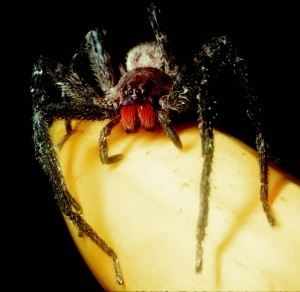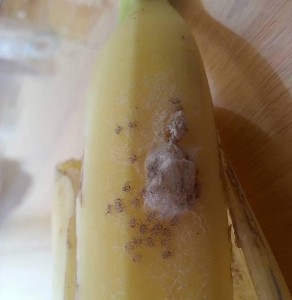Aren’t you glad it wasn’t a dragonfruit?
This is about bananas and “banana spiders,” a slippery concept. I vowed not to make any wordplay on the words “bunch,” “go(ing) bananas,” or “appeal,” because those are hideous journalistic clichés. You’ll thank me.
I did slip in that “slippery,” but I had to, honest.

A mum’s worst nightmare–just add spiders. (Scary banana sculpture by Suu, a Japanese artist. You should see his or her Ben Bernanke!)
What’s fun about chasing down the latest spider scares is discovering that any such story has happened before—usually many times. Better, the story changes. There are certain structures to any “I was scared by a spider” story, like the one where you crash your car, or the one where you need an explanation for a scary sore, or the one where your man proves he’s not a coward. But in general the trends or the public mood allow you to fill in many of the nouns and verbs and places, like some kind of arachnophobic Mad Libs book.
Like this:
(Location) homemaker (proper name) was terrified to discover this week that the healthy (fruit or vegetable) she’d brought home from the supermarket and was about to serve her (numeral) offspring was infested by the world’s most deadly (usually harmless arachnid).
(Proper name) was washing the (foodstuff) when she found the (synonym for dead, mangled, or stunned) spider in a bowl and (word for emitted loud, high-pitched sound). She summoned her (male relative) to strenuously (verb) the beast and phoned the local (unprepared exterminator), who confirmed the (adjective)-eating creature’s identity and insisted on (violent verb with “-ing”) her home.
A spokesman for the supermarket chain expressed sympathy for (name)’s traumatic experience and offered her a free (trivial item meant to forestall a lawsuit).
Today’s story is out of Britain, where they’re already prepared to burn with flame any creature with eight legs, on the theory that it must be one of those cottage-invading, mum-murdering, flesh-eating, snapper-stabbing false widows (Steatoda nobilis). That particular cobweb spider readily turns invisible and assumes disguises wherein it looks like other, equally harmless spiders. It’s quite a trick! I wish I could see it.
(I take back some of what I’ve said about British arachnophobics. I can tell from some of the Facebook warriors and other online commenters that many British people are disgusted and embarrassed by the current spider hysteria. Then there are the good people at the British Arachnological Society, whose site is second to none on getting the spider facts straight.)
(It’s also come to my attention that I may have maligned Weetabix. I sincerely regret any hurt feelings I might have caused.)
But bananas now: in the current variation on Horror in the Fruit Bowl, a London mum was shocked to see baby spiders hatching from the peel of a banana. Spiderlings were emerging from a “white spot” (photos show an egg sac) that she first thought was mold. Trigger-happy reporters promptly plastered websites with stock photos of Phoneutria, a New World wandering spider with a bad bite. Apparently the woman and her plucky pest-control company leaped to the conclusion that the baby spiders were Phoneutria, and from there it devolved into a story about 1. How much the supermarket was going to pay to calm everybody down, and 2. Just how much napalm it would take to wipe out every form of life in the customer’s house, children excepted.
One problem. These were baby spiders. They look pretty much alike. Even an expert can’t tell a baby Phoneutria from a baby Cupiennius, which is a much more likely fruit stowaway, at least to North America, according to this expert report. And Cupiennius is harmless. Big and scary, but harmless. (Anyway, “A baby spider doesn’t have big enough jaws to bite you,” British entomologist Steven Falk told ABC News.)
Also big, fast, and scary looking are huntsman spiders. They hitchhike in bananas, too, and show up in fruit bowls. And are also harmless except to the arachnophobic, which, to be fair, is lots of folks.
Regardless of species, the spiderlings wouldn’t get far on foot. Nor are they likely to survive away from their home climate. All mum needed to do was vacuum them up. Once in the Dirt Devil bag, they won’t be breeding or murdering or doing anything else.

It’s the mustache! Really. Those red jaws belong to Cupiennius chiapanensis (photo from American Entomologist), who gets confused with Phoneutria, another red-‘stached spider with a bad reputation. But all they have in common is the banana.
Not long ago, if a spider showed up invited in a UK fruit bowl it was often given the benefit of the doubt, i.e., not assumed to be the world’s deadliest anything. You can see it in older stories like this, this, this (with the wonderful headline “Where Is Mummy Spider?”) and this. It still bothered the fruit-buying public to find them, but nobody worried it was the start of Arachnoworld War III. They went ahead with tea and biscuits.
But the “false widow” meme seems to have escalated every spider encounter by a jittery public. The postman won’t deliver your mail because a fat, harmless orb weaver is dangling across his path. Someone’s bunny dies (as they do), and because a spider is in the neighborhood, it must be to blame. Spiders are described as leaping and chasing, which they just don’t do. A false widow couldn’t outrun a baby carriage with three missing wheels.
The supermarket chain dug a little deeper into the London story and now leans toward the theory that the spiderlings were harmless Cheiracanthium babies, according to ABC. The so-called yellow sac spider lives all over the world—occasionally it bites, but it never kills. (In my house we call it the “glow in the dark spider” because of its pallor.) But in the end, according to ABC, the store paid the scared shoppers a bunch of money.

